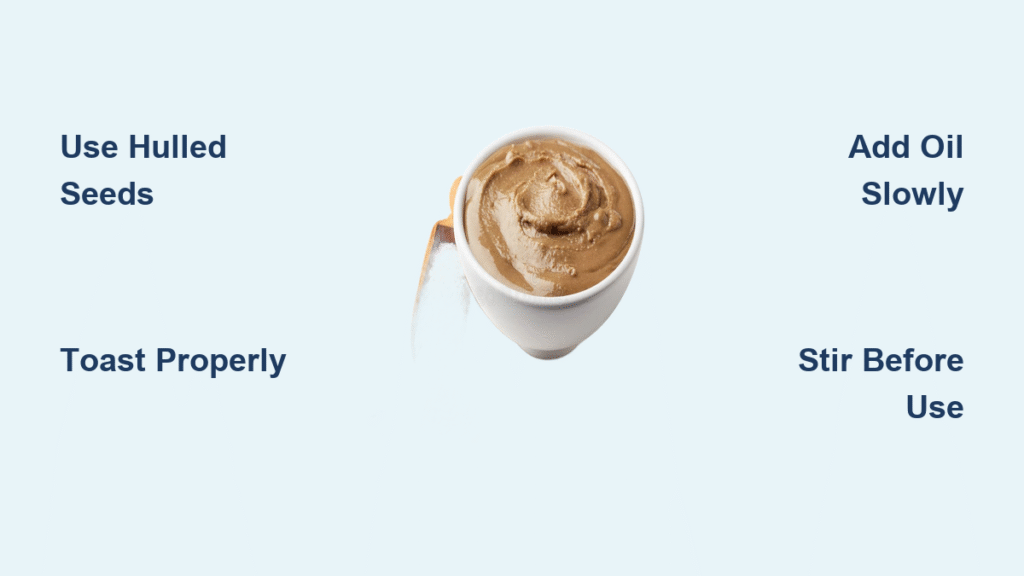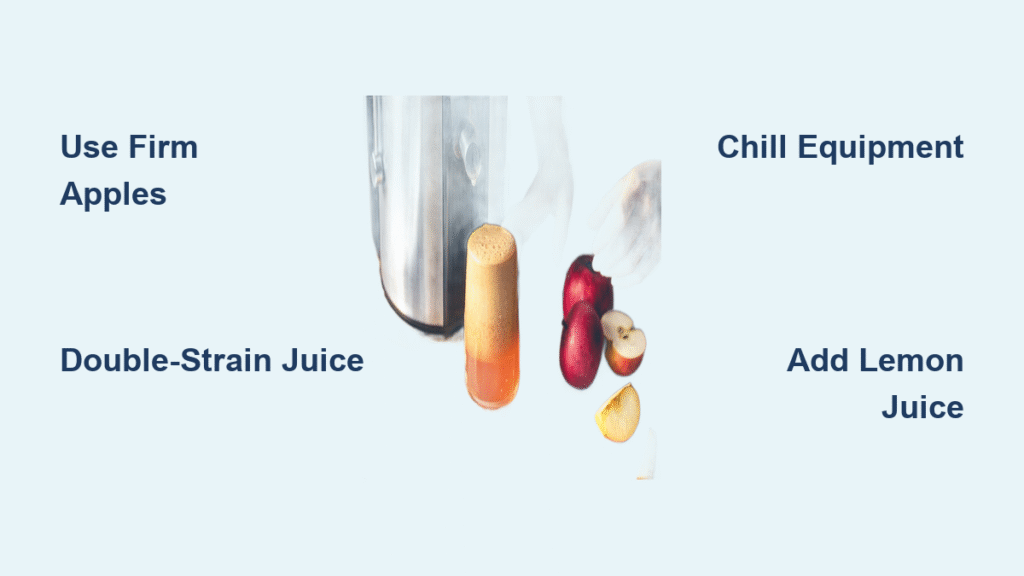Your store-bought tahini sits in the fridge like stubborn cement—gritty, bitter, and impossible to drizzle. But when you make tahini paste with blender, you unlock silky-smooth sesame magic in under five minutes. No more settling for overpriced jars that ruin your hummus or salad dressings. This method guarantees pourable, nutty-sweet tahini for pennies per spoonful, with complete control over texture and flavor. Forget complicated techniques: with just sesame seeds, oil, and your blender, you’ll create restaurant-quality paste that stays fresh for two months.
Homemade tahini transforms everything it touches—from midnight avocado toast to authentic baba ganoush. You’ll avoid the metallic aftertaste of commercial versions and dodge hidden preservatives. Plus, you’ll save 70% compared to premium brands. Whether you’re using a Nutribullet or full-size high-speed blender, this guide covers every variable: seed selection, oil ratios, texture fixes, and pro storage tricks. Let’s turn those humble seeds into liquid gold.
Pick Sesame Seeds for Perfect Texture
Hulled white seeds are non-negotiable for smooth, pourable tahini. Unhulled seeds add fiber and nutrients but create a gritty mouthfeel that even high-powered blenders struggle to eliminate. Black sesame seeds? Save them for dramatic desserts—their intense, almost smoky flavor overwhelms savory dishes unless balanced with honey.
Buy seeds from Asian market bulk bins where prices drop to $3–$4 per pound (vs. $8+ in supermarkets). One pound yields roughly 1¾ cups of tahini—equivalent to five expensive jars. Critical tip: Check seeds for debris or moisture. Damp seeds clump during blending, forcing you to add excess oil that thins your final paste.
Gather Blender-Specific Tools and Ingredients
Skip the food processor—low-powered blenders and mini choppers fail with small seed batches. You need:
– High-speed blender (Nutribullet, Vitamix dry container, or Blendtec)
– Rubber spatula (metal scrapers scratch blender jars)
– Sterilized glass jar (run through dishwasher cycle)
– Neutral oil like sunflower or grapeseed (olive oil turns bitter under high speed)
| Batch Size | Sesame Seeds | Starting Oil | Salt | Yield |
|---|---|---|---|---|
| Small | ½ cup | 4 Tbsp | Pinch | ⅓ cup |
| Standard | 1 cup | 1 tsp | Pinch | 1 cup |
| Double | 2 cups | 2 tsp | ½ tsp | 2 cups |
Why oil amounts vary: Smaller batches need more oil to lubricate the grind. Never skip the initial oil—it prevents motor burnout when seeds stall.
Toast Seeds Without Burning (3-Minute Fix)
Dump seeds into a dry skillet over medium-high heat. Stir constantly with a wooden spoon until they smell like warm bread and turn pale gold—exactly 3–4 minutes. One extra minute creates acrid bitterness that ruins your tahini. Immediately slide seeds into a bowl to stop cooking.
Skip toasting only if you want raw, grassy-flavored tahini for specific diets. But 95% of home cooks prefer toasted depth. Visual cue: Perfectly toasted seeds look ivory, not tan. Burnt seeds turn dark brown at the edges—toss them and restart.
Load Blender and Grind to “Damp Sand” Stage

Pour cooled seeds into your blender. Pulse in 20-second bursts—never continuous blending. Stop to scrape sides with a rubber spatula every 30 seconds. You’re aiming for a uniform, crumbly texture like damp beach sand.
Blender SOS: If seeds just spin without grinding, add 1 tsp oil immediately. Low-powered blenders (under 1000 watts) often need this kickstart. Stop when seeds release visible oils and cling to the jar walls—no dry powder remains.
Stream Oil for Silk-Textured Tahini
Add your starting oil plus salt. Blend again in 15-second bursts. Watch the magic: the paste first clumps like wet soil, then suddenly transforms into a glossy ribbon. Total time: 1½ minutes in high-speed blenders, up to 4 minutes in weaker models.
Thinning hack: For drizzle-ready consistency, stream in oil while blending on “smoothie” mode. Add only ½ tsp at a time—over-thinning forces you to add more seeds later. Perfect texture test: Dip a spoon—the tahini should coat it evenly but drip slowly.
Fix Gritty or Separated Tahini Instantly

Why Your Tahini Feels Sandy and How to Save It
Grittiness means seeds didn’t fully emulsify. Immediately:
1. Scrape down sides
2. Add 1 tsp oil
3. Blend 20 seconds more
If still gritty, your seeds were unhulled—switch to hulled next time.
Paste Too Thick? Thin Without Diluting Flavor
DO NOT add water—it breaks the emulsion. Instead:
– Drip ½ tsp neutral oil into running blender
– Pulse 10 seconds
– Repeat until pourable
Thick tahini often means insufficient initial oil or under-toasted seeds.
Runny Tahini Rescue Trick
Over-thinned paste can be fixed:
1. Measure 1 Tbsp untoasted seeds
2. Blend into runny tahini for 15 seconds
3. Rest 10 minutes—the seeds absorb excess oil
Never skip this: Adding more oil to fix runniness creates a permanent watery mess.
Flavor Hacks for Restaurant-Quality Tahini
Sweet Tahini for Desserts
Blend ½ tsp honey and ¼ tsp vanilla into 1 cup tahini. Pro move: Use black sesame seeds for dramatic chocolate swirls in brownies—balance bitterness with extra honey.
Lightning-Fast Salad Dressing
Combine 3 Tbsp homemade tahini with:
– 3 Tbsp ice water
– 1 Tbsp lemon juice
– 1 minced garlic clove
Whisk 20 seconds—creamy, pourable dressing in under a minute. Store-bought versions taste chalky in comparison.
Japanese Goma Dressing Secret
Toast seeds until deep amber (not gold!), then blend with:
– 1 Tbsp rice vinegar
– 1 tsp honey
– Pinch of white sesame seeds
Drizzle over cold noodles—the nutty depth beats bottled versions.
Store Tahini to Prevent Rancidity
Scoop warm tahini into a sterilized jar using a rubber spatula—never metal (causes oxidation). Seal immediately and refrigerate. Shelf life: 2 months for hulled-seed tahini, 1 month for unhulled.
Oil separation is normal—it means no emulsifiers were added. Fix instantly: Stir with chopstick before use. Rancidity test: Smell for sourness or paint-like odor; discard if detected. Pro tip: Press plastic wrap directly onto the tahini surface before sealing to block air exposure.
Scale Batches Without Overheating Your Blender

Small-Batch Bullet Blender Success
Stick to ½ cup seeds max in Nutribullet-style blenders. Critical: Pause every 30 seconds to let the motor cool. Add oil in 1-tsp increments—small jars need 4 Tbsp total oil to prevent stalling.
Double-Batch Safety Protocol
For 2 cups of seeds:
1. Use full-size blender’s dry-grain container
2. Blend 45 seconds → rest 60 seconds
3. Repeat until smooth (total 4–5 minutes)
Overheating sign: Burning plastic smell—stop immediately and cool motor 15 minutes.
Why Homemade Tahini Beats Store-Bought Every Time
Your $6 jar of store tahini contains stabilizers like cottonseed oil that mute sesame flavor. Homemade delivers intense nuttiness because you control the toast level—and costs $1.50 per cup versus $6+ retail. Plus, you avoid the gritty texture caused by industrial grinding methods.
Real-world test: Dip pita bread in both versions. Store-bought clings in dry clumps; homemade coats smoothly with lingering nutty sweetness. That’s the power of fresh, unadulterated sesame oils.
Final pro move: Toast 2 cups of seeds weekly, freeze in zip bags, and blend single servings as needed. You’ll have warm, fragrant tahini ready faster than opening a jar. Label jars with dates—rotate stock so the oldest gets used first. Within days, you’ll wonder why you ever settled for anything less than silky, custom-blended tahini made in your own kitchen.





